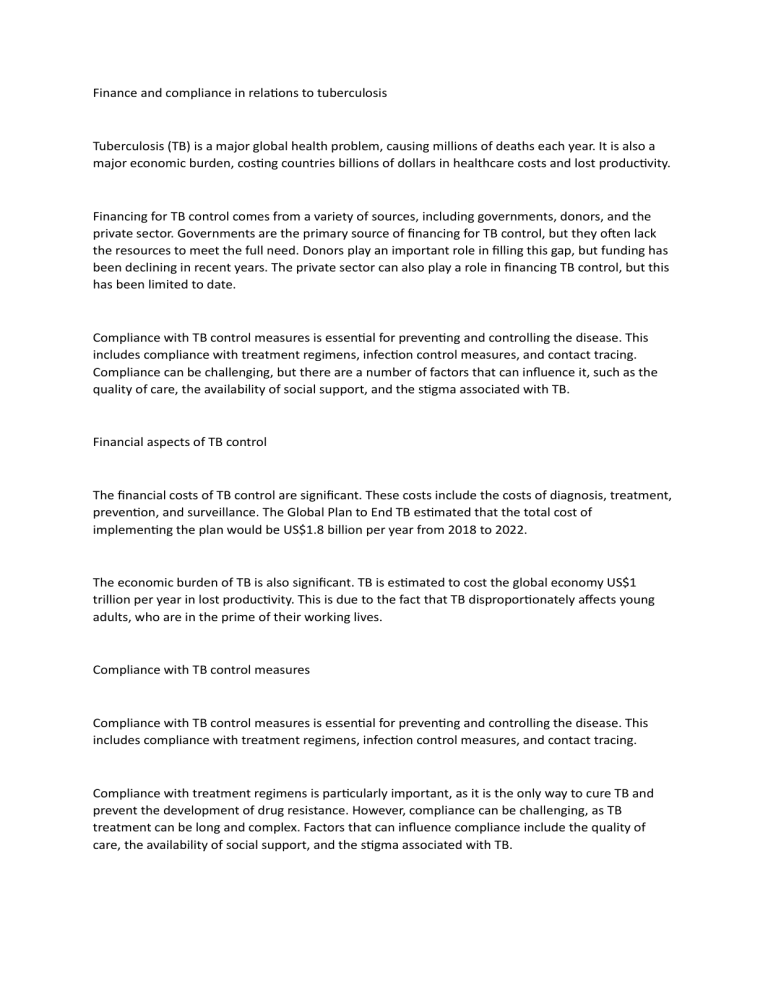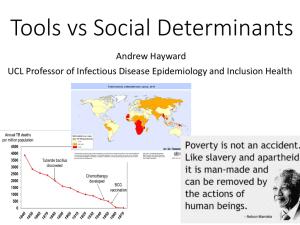
Finance and compliance in relations to tuberculosis Tuberculosis (TB) is a major global health problem, causing millions of deaths each year. It is also a major economic burden, costing countries billions of dollars in healthcare costs and lost productivity. Financing for TB control comes from a variety of sources, including governments, donors, and the private sector. Governments are the primary source of financing for TB control, but they often lack the resources to meet the full need. Donors play an important role in filling this gap, but funding has been declining in recent years. The private sector can also play a role in financing TB control, but this has been limited to date. Compliance with TB control measures is essential for preventing and controlling the disease. This includes compliance with treatment regimens, infection control measures, and contact tracing. Compliance can be challenging, but there are a number of factors that can influence it, such as the quality of care, the availability of social support, and the stigma associated with TB. Financial aspects of TB control The financial costs of TB control are significant. These costs include the costs of diagnosis, treatment, prevention, and surveillance. The Global Plan to End TB estimated that the total cost of implementing the plan would be US$1.8 billion per year from 2018 to 2022. The economic burden of TB is also significant. TB is estimated to cost the global economy US$1 trillion per year in lost productivity. This is due to the fact that TB disproportionately affects young adults, who are in the prime of their working lives. Compliance with TB control measures Compliance with TB control measures is essential for preventing and controlling the disease. This includes compliance with treatment regimens, infection control measures, and contact tracing. Compliance with treatment regimens is particularly important, as it is the only way to cure TB and prevent the development of drug resistance. However, compliance can be challenging, as TB treatment can be long and complex. Factors that can influence compliance include the quality of care, the availability of social support, and the stigma associated with TB. Infection control measures are also important for preventing the spread of TB. These measures include coughing into a handkerchief or sleeve, and avoiding close contact with people who have TB. However, compliance with infection control measures can be difficult, as they often require changes in behavior. Contact tracing is another important TB control measure. Contact tracing involves identifying and testing the contacts of people with TB, in order to identify and treat early cases of infection. However, contact tracing can be challenging, as it requires people to disclose their contacts and to be cooperative with the health authorities. Conclusion Finance and compliance are essential for the effective control of TB. Governments, donors, and the private sector all have a role to play in financing TB control. Compliance with TB control measures is also essential for preventing and controlling the disease. Creative response Imagine a world where TB is eradicated. What would this mean for the global economy? How much more productive would people be if they were not sick with TB? How much money would be saved on healthcare costs? The eradication of TB is a realistic goal. With the right financial and political commitment, it is possible to create a world where TB is no longer a threat. Finance and compliance play a vital role in the fight against tuberculosis (TB). TB is a preventable and treatable infectious disease, but it remains a major global health problem. In 2020, TB was responsible for 1.5 million deaths worldwide. TB financing is essential to ensure that all people with TB have access to quality care and to prevent the spread of the disease. However, TB is often underfunded, and there is a significant gap between the resources needed to control TB and the resources that are actually available. TB compliance is also essential to the success of TB control programs. When people with TB do not complete their treatment, they can remain contagious and spread the disease to others. Compliance can also be a challenge for people with TB due to a variety of factors, including poverty, stigma, and lack of access to healthcare. There are a number of ways to improve finance and compliance in relation to TB. One important step is to increase funding for TB programs. This can be done by increasing government spending on TB, as well as by encouraging private sector investment. Another important step is to improve TB compliance. This can be done by making TB services more accessible and affordable, by reducing stigma associated with TB, and by providing support to people with TB to help them complete their treatment. Finally, it is important to ensure that TB programs are transparent and accountable. This can be done by strengthening oversight mechanisms and by making information about TB financing and compliance publicly available. By improving finance and compliance in relation to TB, we can make significant progress towards the goal of ending TB. Tuberculosis (TB) is a contagious infectious disease caused by the bacteria Mycobacterium tuberculosis. It is one of the top 10 causes of death worldwide, and it is estimated that one-third of the world's population is latently infected with TB. TB can be cured with antibiotics, but treatment is long and complex. In addition, TB is becoming increasingly resistant to antibiotics, making treatment even more difficult. Finance and compliance play an important role in the fight against TB. Adequate funding is needed for TB research, prevention, and treatment programs. In addition, compliance with TB control measures is essential to preventing the spread of the disease. Here are some specific ways in which finance and compliance relate to TB: Funding for TB research: TB research is essential to developing new and more effective ways to prevent, diagnose, and treat the disease. However, TB research is underfunded, especially in developing countries. Increased funding for TB research would help to accelerate the development of new tools to combat TB. Funding for TB prevention programs: TB prevention programs are essential to stopping the spread of the disease. These programs include contact tracing, vaccination, and education about TB. However, TB prevention programs are also underfunded, especially in developing countries. Increased funding for TB prevention programs would help to reduce the number of new TB cases each year. Funding for TB treatment programs: TB treatment programs provide antibiotics and other support to people with TB. However, TB treatment programs are also underfunded, especially in developing countries. Increased funding for TB treatment programs would help to ensure that everyone with TB has access to the care they need. Compliance with TB control measures: TB control measures include isolation of people with contagious TB, treatment of people with TB, and contact tracing. Compliance with TB control measures is essential to preventing the spread of the disease. However, compliance is often low, especially in developing countries. This is due to a number of factors, including stigma, lack of access to care, and financial barriers. There are a number of ways to improve finance and compliance in relation to TB. One way is to increase funding for TB research, prevention, and treatment programs. This could be done through government funding, private donations, or a combination of both. Another way to improve finance and compliance is to reduce the financial barriers to TB care. This could be done by providing financial assistance to people with TB and by reducing the cost of TB medications. Finally, it is important to raise awareness about TB and to reduce the stigma associated with the disease. This will help to encourage people to seek care and to comply with TB control measures. Improving finance and compliance in relation to TB is essential to reducing the burden of this disease worldwide. By investing in TB research, prevention, and treatment, and by reducing the financial barriers to TB care, we can help to save lives and prevent the spread of TB.




